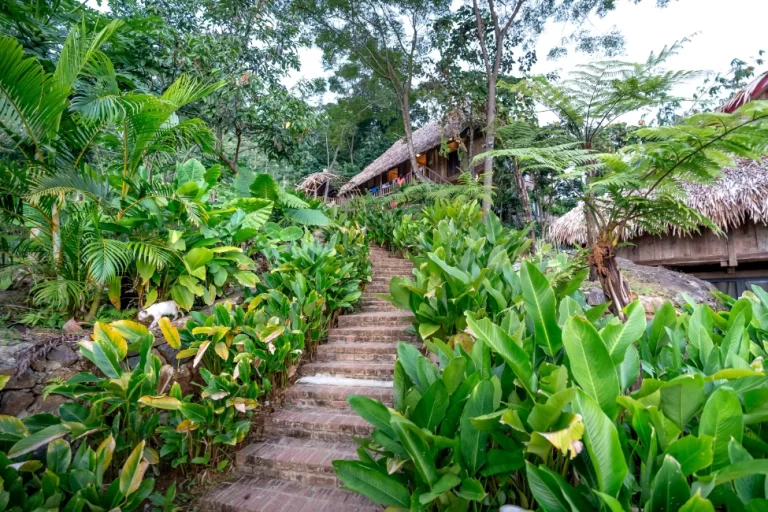Overtourism: Causes, Effects, and Solutions Explained

Overtourism has become a growing concern in recent years, as the tourist industry continues to expand worldwide. Simply put, overtourism is when an excessive number of tourists visit a destination, negatively impacting the environment and local communities.
In this blog post, we will delve into the various causes of overtourism and explore its detrimental effects on popular travel destinations. Furthermore, we will take a look at potential solutions that can help alleviate this issue while maintaining sustainable tourism practices.
Lastly, I’ll share some tips on how we as travelers can contribute to reducing overtourism and promote responsible tourism for future generations to enjoy these incredible places, like a UNESCO World Heritage site and more, around the world.
What is Overtourism?
Overtourism is a relatively new term that has gained popularity in recent years as an increasing number of destinations around the world are struggling with excessive numbers of tourists. Overtourism is a situation in which the amount of visitors to a certain area exceeds its capacity, leading to adverse effects on the environment, local inhabitants, and tourist experience.
This phenomenon has been observed in popular tourist spots such port cities such as Venice, Amsterdam, and remote locations like Mount Everest. As more people have access to affordable travel options and cheap flights, it’s becoming increasingly important for travelers, local and national governments, and travel industry stakeholders alike to understand what overtourism is and how we can work together toward finding sustainable solutions.
A Growing Global Concern
The issue of overtourism isn’t limited to just one or two countries; it’s a growing global concern affecting numerous cities, towns, natural wonders, and cultural heritage sites across continents. According to the United Nations World Tourism Organization (UNWTO), international tourist arrivals reached 1.4 billion in 2018 – two years ahead of its initial forecast. This rapid growth in the tourist industry has led to overcrowding and overuse of resources in many popular destinations, ultimately threatening their long-term sustainability.
Understanding the Impact
Overtourism isn’t just about large crowds or long lines at attractions; it’s a complex issue with far-reaching consequences that can affect the environment, local communities, and cultural heritage.
By understanding these impacts, we can better appreciate why finding solutions to tourists visiting fragile environments is crucial for preserving our planet’s most treasured places for future generations. A few important ones to consider are:
- Environmental degradation: Overtourism can lead to environmental degradation due to increased pressure on natural resources such as water, energy, and land. The pollution caused by increased tourism can also damage ecosystems, wildlife, and habitats.
- The strain on infrastructure: Overtourism can put a strain on the infrastructure of a destination, including transportation systems, water supply, and waste management. This can lead to issues such as overcrowding, traffic congestion, and increased noise pollution.
- Increased living costs: Overtourism can increase the cost of living for locals, as the demand for goods and services goes up. This can lead to issues such as gentrification, displacement of local residents, and an increase in the cost of basic necessities such as food and housing.
- Loss of cultural heritage: Overtourism can lead to the loss of cultural heritage as local traditions and customs are replaced by tourism-driven activities. This can lead to a loss of identity and a decline in the authenticity of the destination.
- Negative impacts on local communities: Overtourism can have negative impacts on the quality of life for local communities. Increased tourism can lead to overcrowding, noise pollution, and a loss of privacy, which can negatively impact the well-being of residents.
Causes of Overtourism
Overtourism is a complex issue with multiple contributing factors. Understanding these causes can help us identify solutions and promote responsible travel practices. Let’s take a closer look at some of the primary drivers behind overtourism:
Affordable Travel Options
One significant factor contributing to overtourism is the increased availability of affordable travel options, such as low-cost airlines and budget accommodations like Airbnb. These options have made it easier for more people to explore new destinations, leading to an influx of tourists visiting popular areas.
As an avid traveler myself, I love that travel has become so much more accessible and affordable. But we do have to be mindful of the negative impact this may have on other communities or locations.
Social Media Influence
The rise of social media platforms like Instagram has also played a role in driving tourism demand. As users share stunning photos and experiences from their travels, others are inspired to visit those exact locations – often resulting in overcrowding at once-undiscovered gems.
FOMO (Fear Of Missing Out)
- FOMO: The fear that if you don’t visit a particular destination now, you’ll miss out on something special or unique drives many travelers’ decisions when planning trips. This mentality contributes significantly to overtourism as everyone rushes to experience trending locations before they become “overrated” or too crowded.
Inadequate Infrastructure & Planning
Many tourist hotspots lack the necessary infrastructure and planning strategies required for managing large numbers of visitors effectively. In large part, this is because these historic locations were not built for tourism at all, but rather for everyday use.
Churches and mosques, for example, were built as places of worship for the local community, not for thousands of people to be ushered through every hour.
When local governments fail to anticipate growth in tourism demand or invest adequately in facilities such as public transportation systems, waste management services, city centers, and accommodation options, this can exacerbate issues related to overcrowding and environmental degradation.
Cruise Ship Tourism Impact
Cruise ships are another contributor to overtourism. These massive vessels can bring thousands of visitors to a destination in one day, overwhelming local infrastructure and resources. The short duration of these visits also means that the economic benefits for local communities are often minimal compared to the environmental and social impacts.
Mass Tourism & Package Tours
The rise of mass tourism and package tours has also led many travelers to visit popular destinations during peak seasons, further contributing to overcrowding issues. While these types of trips offer convenience and affordability, they often result in large groups descending on tourist attractions simultaneously – putting significant strain on both the environment and local communities.
The Gist: Overtourism is a complex issue caused by multiple factors such as increasingly affordable travel options, social media influence, FOMO, inadequate infrastructure and planning, cruise ship tourism impact, and mass tourism. To combat overtourism effectively, it’s crucial for all stakeholders in the tourist industry to work together towards sustainable solutions that balance economic growth with preserving our planet’s natural beauty and cultural heritage.
Effects of Overtourism
Overtourism has a wide range of negative impacts on both the environment and local communities in popular travel destinations. In this section, we will examine some of the most significant effects that result from overtourism.
Environmental Damage
Unfortunately, the influx of tourists to an area can lead to severe environmental degradation. For example, increased foot traffic in natural areas like coral reefs and hiking trails can cause erosion and damage delicate ecosystems. Transportation-related pollution, such as from airplanes and cruise ships, is a major factor in climate change that exacerbates environmental issues.
Overcrowding
In many popular tourist destinations, overcrowding is becoming a serious problem due to too many visitors. The influx of tourists leads to overcrowding, creating long queues and putting immense strain on the local infrastructure. The city of Venice is a prime example where overcrowding from too many tourists has become so extreme, it’s driving locals away from their homes.
- Noise Pollution: Increased tourism often results in excessive noise levels due to large crowds or late-night partying – affecting both wildlife habitats and residents’ quality of life.
- Lack of Resources: Overcrowded destinations may struggle with providing adequate resources for their population – including water supply or energy generation – leading to shortages for locals during peak tourist seasons.
Cultural Erosion
The impact of overtourism on local culture can be significant. As destinations become more focused on catering to tourists, they may lose their unique cultural identity and authenticity. This is sometimes referred to as a “Disney-like” effect, where the original character of an area gets replaced by something that has been made for mass appeal.
In some cases, overtourism can even lead to the displacement of local residents due to rising living costs or property development aimed at accommodating tourists (e.g., hotels, restaurants).
When I visited Lisbon, Portugal last summer (2022) I heard from many locals that they can no longer afford to live in the center of the city. Many landlords in the downtown area prefer to convert their properties to AirBnbs or other short-term rentals that will bring in a higher income.
This further erodes the sense of community and connection between locals and their environment.
Economic Inequality
While tourism undoubtedly brings economic benefits to an area, it’s essential to consider how these benefits are distributed among the local population. Oftentimes, only a small portion of people in tourist-heavy areas reap financial rewards from increased visitor numbers – leaving many locals struggling with higher living costs without seeing any improvement in their quality of life.
The Gist: Overtourism can have negative impacts on the environment and local communities, causing environmental damage, overcrowding, noise pollution, lack of resources, cultural erosion, and economic inequality. It’s important for travelers and tourism industry stakeholders to recognize these issues and work towards sustainable solutions that benefit both the tourist industry and the locals.
Solutions to Overtourism
Overtourism is an increasingly pressing problem for many historic cities and tourist destinations globally. There are various approaches to address its adverse effects.
By implementing sustainable tourism initiatives and adopting responsible travel practices, we can all contribute to preserving these beautiful places for future generations.
Sustainable Tourism Initiatives
Sustainable tourism aims to minimize the impact of tourism on the environment and local communities while providing economic benefits. Governments, local authorities, businesses, and travelers alike have a role in promoting sustainable tourism through various initiatives:
- Eco-friendly accommodations: Hotels and other eco-lodging options can adopt eco-friendly practices such as using renewable energy sources, reducing water waste, or offering locally sourced food. This can be a great way to decrease the negative impact on the environment.
- Tourist taxes: Some destinations have implemented tourist taxes that fund environmental conservation efforts or support local infrastructure improvements.
- Limits on visitor numbers: To prevent overcrowding at popular sites, some locations have introduced limits on daily visitors or require advanced reservations for entry.
- Promoting off-peak travel: Encouraging tourists to visit during less busy times of the year helps distribute visitor numbers more evenly throughout the year.
- Slow travel: Instead of planning a short trip to hit all the top tourist sites, slow travel advocates for taking a longer trip and spending more time in a destination to explore it more wholly.
Related: Best Eco-Lodge in Costa Rica? My Top 7 Picks
How You Can Help
By adopting responsible travel practices and supporting local businesses, you can help promote sustainable tourism and preserve these beautiful places for future generations.
Choose Off-the-Beaten-Path Destinations
Rather than visiting popular tourist hotspots that are already experiencing overtourism, consider exploring lesser-known destinations. These hidden gems often offer equally stunning landscapes and rich cultural experiences without contributing to overcrowding or straining local resources.
This doesn’t mean you should completely skip the top destinations. There is a reason they became popular and they are with seeing. Simply consider where you can add some balance.
Travel During Shoulder Seasons
Another way to reduce your impact on overtouristed areas is by traveling during the shoulder seasons – periods between peak and off-peak travel times when visitor numbers are lower. Not only will this help ease pressure on local infrastructure, but it also allows you to enjoy a more relaxed experience with fewer crowds.
Support Local Businesses
- Eat at locally-owned restaurants: Opt for dining establishments run by locals instead of international chains; this supports community members while giving you an authentic taste of regional cuisine.
- Purchase souvenirs from artisans: When shopping for keepsakes or gifts, choose items made by local craftspeople rather than mass-produced trinkets; this helps support traditional skills and provides income directly to those who need it most. Check out this guide on how to find authentic, locally-made souvenirs.
- Hire guides from the area: Employing knowledgeable locals as tour guides not only offers unique insights into the destination but also creates job opportunities for residents.
Practice Responsible Tourism
Being aware of one’s effect on the environment, culture and people in a place visited is an important part of being a more responsible tourist and traveler. Some ways to practice responsible tourism include:
- Respect local customs and traditions: Take time to learn about cultural norms and practices before arriving at your destination; this helps foster understanding between visitors and locals.
- Minimize waste: Carry reusable items such as water bottles, shopping bags, or cutlery to reduce single-use plastic consumption during your trip. The Leave No Trace Center for Outdoor Ethics offers guidelines on minimizing your impact when visiting natural areas, such as disposing of waste properly and respecting wildlife. I love this resource and highly recommend it.
- Promote sustainable transportation options: Whenever possible, choose public transport or non-motorized modes of travel like walking or cycling over private vehicles; this reduces emissions while allowing you to immerse yourself more fully in the local environment.
Tackling overtourism is a collective effort that requires cooperation from all stakeholders – including tourists visiting these destinations. By making conscious choices about where we go, when we travel, how we spend our money, and how we interact with our surroundings, each one of us can contribute towards preserving these incredible destinations for generations to come and supporting the tourist industry in a sustainable way.
The Gist: To help alleviate the negative impacts of overtourism, travelers can adopt responsible travel practices such as choosing off-the-beaten-path destinations, traveling during shoulder seasons, supporting local businesses by eating at locally-owned restaurants and purchasing souvenirs from artisans. Additionally, practicing responsible tourism by respecting local customs and traditions, minimizing waste and promoting sustainable transportation options can contribute towards preserving these incredible destinations for generations to come.
Conclusion
In conclusion, overtourism is a growing problem that can have negative impacts on both the environment and local communities. It is caused by a variety of factors, including cheap air travel, lack of regulation, and social media promotion. The effects include overcrowding, strain on resources, and damage to cultural heritage sites.
However, there are solutions to this issue, such as promoting sustainable tourism practices and implementing regulations. As travelers ourselves, we can also do our part in reducing overtourism by choosing off-season travel times or visiting lesser-known destinations.
If you want to learn more about how you can help combat overtourism while still enjoying your travels responsibly, check out my blog. Together, we can make a positive impact on the world!





